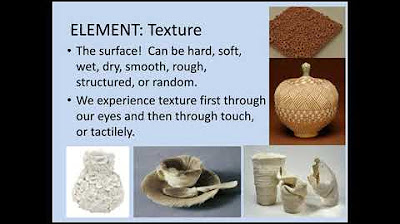Understanding the Elements of Art
Summary
TLDRThis educational video delves into the fundamental elements of art, comparing them to the basic ingredients of a recipe. It explores concepts like line variation, value, color, space, and texture, using examples from renowned artists to illustrate these principles. The video distinguishes between two-dimensional shapes and three-dimensional forms, highlighting the differences between geometric and organic shapes. It also explains the importance of positive and negative space in composition and the distinction between actual and visual texture. The engaging presentation aims to equip viewers with the vocabulary to discuss and appreciate art more deeply.
Takeaways
- 🎨 The elements of art are the building blocks of artwork, similar to ingredients in a recipe or chemical elements in nature.
- 📏 Line is a fundamental element of art, defined as a mark with length and direction, and can be described using various adjectives like straight, curvy, or jagged.
- 🎭 Line variation refers to the use of different thicknesses in lines to create visual interest, impacting the weight and impact of the artwork.
- 👀 Contour lines are lines that follow the outer edges of an object, often used as outlines, and can be manipulated to create different visual effects.
- 🤓 Blind contour is a drawing technique where the artist draws without looking at the paper, focusing on the subject to develop spatial skills and enhance observational drawing.
- 🌟 Value in art represents the lightness or darkness of an element, with scales ranging from light to dark, and is crucial for creating depth and contrast.
- 🌈 Color is seen by the reflection of light off an object, and its description involves terms like hue, intensity, and saturation, which define the characteristics of the color.
- 🌌 Space in art can be shallow or deep, affecting the perceived depth and three-dimensionality of the artwork, with shallow space feeling more confined and deep space offering a sense of vastness.
- 📐 Positive and negative space are terms used to describe the focused areas and the background in an artwork, respectively, and can be cleverly utilized to create visual interest and guide the viewer's eye.
- 🔲 Shape and form are distinguished by their dimensionality, with shapes being two-dimensional and forms being three-dimensional, and can be geometric or organic in nature.
- 🖌️ Texture is the perceived or actual feel of a surface, with actual texture being physically felt and visual texture being implied through the artwork's appearance.
Q & A
What are the elements of art?
-The elements of art are the building blocks of artwork, similar to ingredients in a recipe or chemical elements in life. They include line, color, value, shape, texture, and space.
How is a line defined in the context of art?
-In art, a line is defined as a mark with length and direction, and it can be described using various adjectives such as straight, curvy, jagged, hatched, scribbly, zigzag, curly cue, and drippy.
What is line variation in art?
-Line variation refers to the use of a variety of thin and thick lines, or the weight of a single line, to create interest in an artwork.
Can you explain contour lines in art?
-Contour lines are lines that follow the outer edges of an object, acting like an outline. They are among the first lines drawn when learning about art.
What is blind contour drawing?
-Blind contour drawing is the technique of drawing contour lines without looking at the paper, forcing the artist to focus on the subject and develop spatial skills.
What does the term 'value' represent in art?
-In art, value refers to the lightness or darkness of an element, indicating whether things are black, gray, or white.
How do we perceive color in art?
-Color in art is perceived through the reflection of light off an object. Different parts of the light spectrum bounce back and are interpreted by our eyes and brain as color.
What is the difference between hue, intensity, and saturation when describing color?
-Hue is the name of a color, intensity refers to the brightness or dullness of a color, and saturation is the level of intensity or vividness of a color.
What are the two types of space in art?
-The two types of space in art are shallow space, which involves little depth, and deep space, which involves a lot of depth. Shallow space feels flat with objects close together, while deep space gives a sense of distance and room to move around.
Explain the concept of positive and negative space in art.
-Positive space in art refers to the areas of focus, the important parts that the artist wants the viewer to look at first. Negative space is the area around the positive space, usually the background.
What is the difference between shape and form in art?
-Shape refers to two-dimensional elements with height and width, while form refers to three-dimensional elements that also have depth. Geometric shapes and forms are based on mathematical principles with hard edges, whereas organic shapes and forms are natural and freeform with soft edges.
How is texture categorized in art?
-Texture in art is categorized into actual texture, which can be physically felt, and visual texture, which is implied and can only be seen but not felt.
Outlines

Esta sección está disponible solo para usuarios con suscripción. Por favor, mejora tu plan para acceder a esta parte.
Mejorar ahoraMindmap

Esta sección está disponible solo para usuarios con suscripción. Por favor, mejora tu plan para acceder a esta parte.
Mejorar ahoraKeywords

Esta sección está disponible solo para usuarios con suscripción. Por favor, mejora tu plan para acceder a esta parte.
Mejorar ahoraHighlights

Esta sección está disponible solo para usuarios con suscripción. Por favor, mejora tu plan para acceder a esta parte.
Mejorar ahoraTranscripts

Esta sección está disponible solo para usuarios con suscripción. Por favor, mejora tu plan para acceder a esta parte.
Mejorar ahora5.0 / 5 (0 votes)






